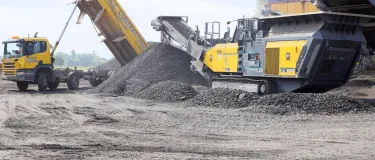The environmental benefits of recycled aggregates

Energy consumption and CO2 emissions associated with the building and construction sector have reached new all-time highs. In the face of a looming and potentially irreversible climate crisis, it’s up to key players in the industry to make eco-friendly decisions and strive towards a more sustainable future. One way to achieve this is through the use of recycled aggregates.
Summary of key points:
- Recycled aggregates are re-processed aggregates derived from demolition or construction waste
- There are many sources of material for recycled aggregates, and each type of material will undergo a number of specific processes to turn it into a valuable construction material.
- Types of recycled aggregate: Type 1, 6F2, Dust and Sand, Topsoil, Pipe Bedding
- Advantages: Reliable and Durable, Versatile, Promotes a Circular Economy, Reduces demand on virgin resources, Cost effective
What is recycled aggregate?
Recycled aggregates are re-processed aggregates derived from demolition or construction waste. Rather than harvesting new sand, gravel, or crushed stone, recycled aggregates contribute to a circular economy by repurposing reclaimed material and waste.
How are aggregates recycled?
There are many sources of material we can repurpose as recycled aggregates, and each type of material will undergo a number of specific processes to turn it into a valuable construction material. In most cases, recycled aggregate is created by collecting waste material from demolished buildings or construction sites. Once collected, it is refined to remove any unwanted commodities, such as wood or metal. Next, the material is compressed with large crushing machines, and where necessary screened and graded, to ensure the material meets the necessary specifications for the intended application. Finally this material can be used in its refined form, or can be blended with virgin materials to become a valuable resource for the building and construction sector.

Types of recycled aggregates
The type of recycled aggregate that can be used depends on the application for which it is intended. For example; You can’t use the same type of recycled aggregate in road construction as you would when creating a new sports ground. Thankfully, there are many types of recycled aggregate available to meet your construction needs.
6F2
6F2 is a coarse and durable site based recycled aggregate, acquired by using materials extracted, screened, processed and re-used at a construction site. It is composed of crushed concrete, brick and mortar all produced as a by-product of demolition projects.

Dust and Sand
Recycled dust or sand is typically employed to backfill trenches, cover on-site pipes, and provide paving solutions. It can also be used for a vast variety of construction projects depending on properties and applications.
Topsoil
A form of recycled soil, topsoil is used for landscaping, sporting areas, and open spaces.
Pipe Bedding
Pipe bedding is a form of recycled aggregate commonly used for drainage purposes.
The advantages of recycled aggregate
The advantages of recycled aggregate are widespread, but here are just a few.
Reliable and Durable
No matter the intended use, the strength and durability of recycled aggregates are on par with that of traditional aggregates. You’ll achieve the same great consistency and performance as you would with virgin aggregates.
Versatile
Recycled aggregate is incredibly versatile. There are many different types of recycled aggregates on the market, so you are bound to find a sustainable material that fits your construction needs.
Promotes a Circular Economy
The waste material used to produce recycled aggregate re-enters the economy and reduces the demand on our virgin resources. Rather than ending up in a landfill the waste material is repurposed, and our natural resources are protected.

Environmentally Sustainable
Arguably, one of the greatest advantages of recycled aggregate is the fact that it is environmentally sustainable. It typically uses far less energy during the production stages and eliminates the need for quarrying virgin material. In addition, virgin material deposits are where they are. The logistics of moving virgin material from the quarry to the construction site creates carbon, and can often involve a multitude of logistical solutions for a single delivery including ship, rail and road haulage. Recycled aggregates, when processed and re-used locally to the source, can significantly cut down carbon emissions attributed to material haulage.
Disadvantages of recycled aggregate concrete
Recycled aggregates are subject to stringent quality controls in order to meet environmental and performance protocols relevant to the intended use. Suppliers are required to implement detailed Factory Production Controls (FPC) and quality plans that can be followed, maintained and audited. Therefore, you can be confident the performance is equal to that of virgin material, and you can expect no disadvantages.
Uses of recycled aggregates
Recycled aggregate is incredibly versatile and can be used to substitute virgin material in many applications including:
- Backfill trenches
- Curbing
- Pavements
- Road construction
- Landscaping
- Bank protection
- Noise barriers
- Base or fill for drainage
- Concrete manufacturing

Conclusion
As a stakeholder in the construction industry, it’s vital to place sustainability at the forefront of your mission and reduce the burden the sector poses on our planet. Utilising sustainable materials, such as recycled aggregates, can help contribute towards a circular economy, reduce carbon emissions, and even cut construction costs. Aggregate Industries are committed to helping the building and construction sector optimise the use of recycled aggregates and as such have developed Aggneo, a range of construction aggregates that utilise recycled and repurposed material. If you would like to learn how Aggregate Industries can help you meet your climate and sustainability goals, don’t hesitate to reach out to a member of our team.
Frequently Asked Questions
Yes, recycled aggregates are very environmentally friendly. They help preserve natural resources and repurpose waste that would otherwise end up in a landfill.
How much recycled aggregate costs depends on the type of aggregate you require and its intended use. However, it can often be a more cost-effective option than virgin aggregate.








